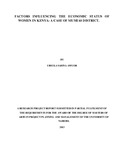| dc.description.abstract | Various national, regional and international conventions and documentation emphasized that enabling the population, regardless of gender to actively participate in social and economic wellbeing is critical for long-term and sustainable social, political and economic development of any society. In Kenya, gender equity had taken centre stage resulting in the development and enactment of various legal and policy interventions including enactment of the National Commission on Gender and Development Act in 2003 and subsequent establishment of the National Commission on Gender and Development in November the same year; introduction of gender desks in key parastatals and police stations; the introduction of the women‘s enterprise fund; the passing of the National Policy on Gender and Development in 2006 and the 30% presidential decree on affirmative action in public appointments, among others. Although, females constituted 51% of the population in Kenya, gender disparities were still persistent in most sectors. This had resulted in poor economic status of women and hence poor growth in the entire population. The purpose of this study was to determine the factors influencing the economic status of women in Mumias District of Kakamega County in Kenya. The objectives of the study included: to assess how cultural practices determine the economic status of women; to establish how the level of education determines the economic status of women; to assess how attitude about women influences economic status of women and lastly to identify challenges experienced by women in their economic status in Mumias District, Kakamega County of Kenya. The target population was drawn from the 2 sub-locations and 1 location of Mumias District will include 1230 women and 33 village elders. A sample of 123 women and 11 village elders was used in the study. The study adopted a descriptive survey design with both quantitative and qualitative aspects. Purposive sampling and simple random sampling techniques was used to select respondents. Data analysis will be conducted objectively. Statistical Package for Social Sciences (SPSS) version 17.0 will be utilized to analyze the collected data. Both descriptive and inferential statistics was be employed in the analysis. The findings will then be presented with the help of simple tables, frequencies and percentages. Results will be interpreted and requisite recommendations made. With respect to the first objective on the influence of culture on the economic status of women in Mumias District of Kakamega County in Kenya, it was observed that cultural practices affected the economic status of women. Majority of the women interviewed agreed that cultural practices affected the economic status of women negatively while only a few of the respondents thought that cultural practices affected the economic status of women positively. The study concluded that there was soaring influence of cultural factors on the economic status of women. These cultural factors included factors as traditional and social practices, poverty and domestic violence, Gender hierarchy shows in family, inheritance laws and customs, valuations of women‘s work as opposed to men‘s work, and the power to make decisions in society, family, church and social networks. These factors seemed to come up in the opportunities available for development, education, health and nutrition. The level of education of women was also found to have a significant effect on the economic status of women. Most of the women said that the usual relationship between education and employment may be related to the likelihood that poorer and lower educated families required female members to work. Most of the respondents also indicated that often, girls and young women worked instead of receiving an education. | en |

